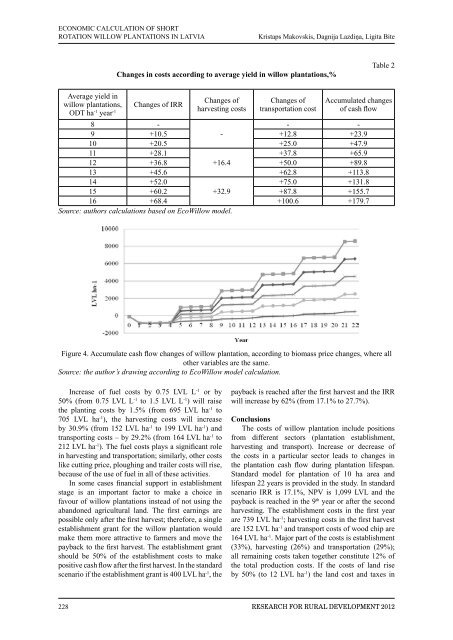RESEARCH FOR
RESEARCH FOR
RESEARCH FOR
Create successful ePaper yourself
Turn your PDF publications into a flip-book with our unique Google optimized e-Paper software.
ECONOMIC CALCULATION OF SHORT<br />
ROTATION WILLOW PLANTATIONS IN LATVIA<br />
Average yield in<br />
willow plantations,<br />
ODT ha -1 year -1<br />
changes in costs according to average yield in willow plantations,%<br />
Changes of IRR<br />
Changes of<br />
harvesting costs<br />
Changes of<br />
transportation cost<br />
Table 2<br />
Accumulated changes<br />
of cash flow<br />
8 -<br />
- -<br />
9 +10.5 -<br />
+12.8 +23.9<br />
10 +20.5 +25.0 +47.9<br />
11 +28.1<br />
+37.8 +65.9<br />
12 +36.8 +16.4<br />
+50.0 +89.8<br />
13 +45.6 +62.8 +113.8<br />
14 +52.0<br />
+75.0 +131.8<br />
15 +60.2 +32.9<br />
+87.8 +155.7<br />
16 +68.4 +100.6 +179.7<br />
Source: authors calculations based on EcoWillow model.<br />
Figure 4. Accumulate cash flow changes of willow plantation, according to biomass price changes, where all<br />
other variables are the same.<br />
Source: the author’s drawing according to EcoWillow model calculation.<br />
Increase of fuel costs by 0.75 LVL L -1 or by<br />
50% (from 0.75 LVL L -1 to 1.5 LVL L -1 ) will raise<br />
the planting costs by 1.5% (from 695 LVL ha -1 to<br />
705 LVL ha -1 ), the harvesting costs will increase<br />
by 30.9% (from 152 LVL ha -1 to 199 LVL ha -1 ) and<br />
transporting costs – by 29.2% (from 164 LVL ha -1 to<br />
212 LVL ha -1 ). The fuel costs plays a significant role<br />
in harvesting and transportation; similarly, other costs<br />
like cutting price, ploughing and trailer costs will rise,<br />
because of the use of fuel in all of these activities.<br />
In some cases financial support in establishment<br />
stage is an important factor to make a choice in<br />
favour of willow plantations instead of not using the<br />
abandoned agricultural land. The first earnings are<br />
possible only after the first harvest; therefore, a single<br />
establishment grant for the willow plantation would<br />
make them more attractive to farmers and move the<br />
payback to the first harvest. The establishment grant<br />
should be 50% of the establishment costs to make<br />
positive cash flow after the first harvest. In the standard<br />
scenario if the establishment grant is 400 LVL ha -1 , the<br />
Kristaps Makovskis, Dagnija Lazdiņa, Ligita Bite<br />
payback is reached after the first harvest and the IRR<br />
will increase by 62% (from 17.1% to 27.7%).<br />
conclusions<br />
The costs of willow plantation include positions<br />
from different sectors (plantation establishment,<br />
harvesting and transport). Increase or decrease of<br />
the costs in a particular sector leads to changes in<br />
the plantation cash flow during plantation lifespan.<br />
Standard model for plantation of 10 ha area and<br />
lifespan 22 years is provided in the study. In standard<br />
scenario IRR is 17.1%, NPV is 1,099 LVL and the<br />
payback is reached in the 9 th year or after the second<br />
harvesting. The establishment costs in the first year<br />
are 739 LVL ha -1 ; harvesting costs in the first harvest<br />
are 152 LVL ha -1 and transport costs of wood chip are<br />
164 LVL ha -1 . Major part of the costs is establishment<br />
(33%), harvesting (26%) and transportation (29%);<br />
all remaining costs taken together constitute 12% of<br />
the total production costs. If the costs of land rise<br />
by 50% (to 12 LVL ha -1 ) the land cost and taxes in<br />
228 ReseaRch foR RuRal Development 2012


